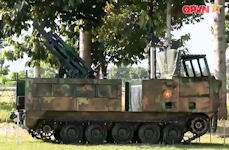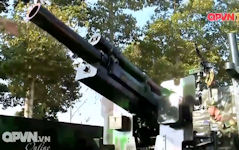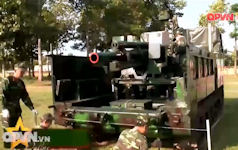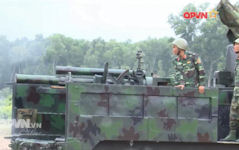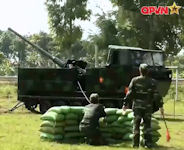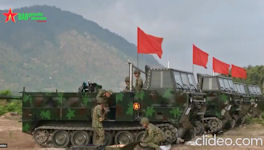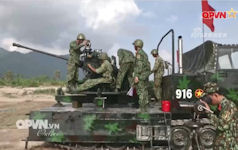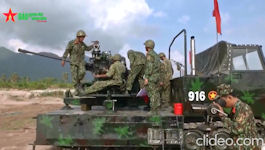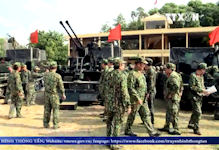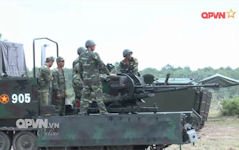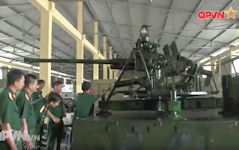M548-105mm; M548-85mm; M548-76mm; M548-37mm-2
Vietnam People Army still fields many refurbished M548 tracked carriers captured from the Vietnam War. While many remain in logistics , some found a new role: direct fire support. Such carriers carry autocannon and howitzers of various calibers from 37mm to 105mm. On 16 April 2019, at Chi Lang shooting range, An Giang province, Military Zone 9 held a real-time shot of the task of science and technology with integrated 85mm, 76mm, 37mm-2 PPK and replicated 105mm cannon, PKMS gun on M548 vehicle. At 2 pre-arranged battlefields, 4 combinations respectively: M548-85mm; M548-76mm; M548-37mm-2; M548-105mm is conducted test shooting at distances 900m, 800m, 600m and 500m. The firing results show that the gun and artillery rack system ensures the quality, works well, the stability of the vehicle when operating and each shot is within the allowed safety limit, ensuring excellent safety of people. and equipment. 4 teams and 6 individuals were awarded certificates of merit by Commander of Military Region 9.
Colonel Ha Tuan Quan, Technical Manager of Military Region 9 said, on November 21, 2018, the Commander of the Military Region assigned the task to the Technical Department to study and install 4 gun combinations 76, 85, PPK 37mm-2 and replicated the mounting of 105mm cannon, PKMS gun to M548. After more than 3 months of implementation, combining theory, experiment and test shots, the science and technology tasks assigned by the Commander of Military Region 9 have been completed on schedule by the Technical Department. Also according to Colonel Ha Tuan Quan, the M548- gun installation complex has outstanding features. Land road speed 60km / h, capable of overcoming steep slopes, steep slopes, cliffs and wide trenches; cannons, guns flexibly use different angles, ranges, and directions.
Over the years, the Military Region has successfully carried out many scientific research and research tasks to install weapons on mobile vehicles. Notably, from 2017 up to now, 17 armored vehicle complexes have been studied and replicated with 33 guns of all kinds. Including 4 vehicle M548-gun 105mm-gun PKMS; 1 combination of M548-gun 23mm; 12 vehicle combinations M113, M106, M125-mortar 100-gun PK12.7mm K54. The above combinations have been equipped for the unit and are being exploited in different states of use, bringing into play effectively in annual real-shot drills, contributing to improving the military's defense potential.
The firing results show that the crawler chassis and pedestal system and the cannon ensure the quality, good performance, the vehicle's stability when operating and each shot is within safe limits, allowing it to meet the technical requirements set out. If the 105mm self-propelled guns or 37mm anti-aircraft artillery mounted on the M548 crawler chassis have been tested since 2018, recently based on the results obtained from the improved artillery combinations mentioned above. 9 continued to launch self-propelled anti-tank gun combinations with caliber from 76mm to 85mm.
With the Vietnam People's Army at present, the guns with these calibers only have long barrel cannon D-44 (85mm) and anti-tank gun ZiS-3 (76mm). The successful mechanization of artillery models such as the D-44 and ZiS-3 is considered a major breakthrough of the Vietnamese defense industry in general and the Military Region 9 in particular. Because with the current combat requirements of the artillery models like the D-44, despite having great power and destructive power, they lack the maneuverability, easily disabled in modern war environments.
Although it has a significantly lower combat weight than the 105mm M101 howitzer, with a barrel length of up to 4.7m for the D-44 and more than 2m for the ZiS-3 will create considerable difficulty in integrating the two. This cannon is mounted on the M548. It is also worth mentioning that the M548 has an overall length, including the cabin, only about 4.8m. However, this concern is likely to have been thoroughly overcome by the Military Region 9 and the test prototypes had a successful test shot at Chi Lang shooting range, An Giang province on April 16.
Also with the M548 undercarriage platform, the crew of traditional towed-gun lines such as the D-44 and ZiS-3 can be reduced from the current 8 gunners to 4 or 3. gun deployment and retrieval times have been significantly improved. At the present time, the D-44 and ZiS-3 are still considered powerful field artillery models of the Vietnam Artillery with a maximum range of up to 15km for the D-44 and more than 13km. with ZiS-3. The goals of these two artillery models are almost unlimited as they can be used to destroy targets such as armored combat vehicles, fortifications, infantry and coastal defense.
A delegation from the Military Science Department of the Ministry of National Defense (MND), led by its Director Major General Ngo Van Giao, visited and worked with the Military Region 9 (MR9) Command on 09 June 2020. During the meeting, the delegation was briefed on the unitís task performance in military science work since 2017. Accordingly, over the past time, MR9 successfully completed projects at Defense Ministry and sectorial levels and many of them have been put into practice.
In addition, the unit also carried out six sector-level projects with excellent results, meeting the management and educational requirements of the schools and studying projects to equip weapons on armored vehicles and military speedboats. Since 2017, dozens of initiatives were awarded certificates by the Defense Ministry and won awards in military competitions.
Especially, in 2918, a project on a 105mm artillery piece and a 7.62mm PKMS machine gun mounted on M548 tracked cargo carrier was honored with the second prize at the Vietnam Creative Awards for Science and Technology. For his part, General Giao highly appreciated the great efforts of the region in implementing military science work over the past time. He also asked the unit to continue effectively implementing Resolution No. 791 and Conclusion No. 62 of the Central Military Commission on scientific, technological, and environmental work in the military. In addition, the unit should also closely work with relevant agencies and units to protect the environment, he concluded.
|
NEWSLETTER
|
| Join the GlobalSecurity.org mailing list |
|
|
|


